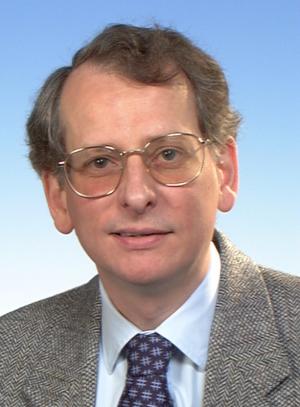Mike Cowlishaw worked for IBM pre-University and as a student from 1971–1974, and then joined IBM’s UK Laboratory at Hursley in 1974 with a BSc in Electrical & Electronic Engineering from the University of Birmingham. Until 1980, he worked on the design and implementation of the hardware and software of microprocessor-based display test equipment and the design automation system used for its hardware. Any spare time was spent exploring the human–machine interface, including implementation of the STET Structured Editing Tool (a ‘folding’ editor which gives a tree-like structure to programs or documentation), several compilers and assemblers, and the REXX programming language.
In 1980 Mike was assigned to the IBM T. J. Watson Research Center, at Yorktown Heights, NY, where he worked on an experimental vector text display with real-time formatting and on enhancements to the VM/CMS operating system.
In 1982 he moved to the IBM UK Scientific Centre in Winchester to work on colour perception; his research into and demonstrations of the fundamental requirements for image presentation contributed to the JPEG standardization initiative as well as to standard colour tables for operating systems. At the same time he worked on ‘TOOLS’ – a large-scale conferencing and software distribution system which became the VM/DSNX product).
In 1985 he was seconded to the Oxford University Press to write a syntax-directed colour-coding editor for the SGML text of the second edition of the Oxford English Dictionary. That editor (the Live Parsing editor, called LEXX) and its LPEX derivatives became part of the IBM VisualAge range of products, running on VM/CMS, OS/2, OS/400, AIX, Windows, Java, and in Eclipse. Mike remains a consultant to the Oxford English Dictionary.
From 1986 to 1990 Mike worked in the IBM UK Laboratories Systems Technology Group on SGML and electronic publishing, working on the ISO standards for SGML and specializing in CD-ROM technologies, PC printers, PostScript, formatting, and indexing; he was Project Editor for ISO TR-10037 (guidelines for SGML editing systems). Electronic Publishing led to him working on Internet technologies, including Gopher and contributing to HTTP 1.0 (RFC 1945), in the early 1990s.
In 1995, Mike ported the Java Virtual Machine (JVM) to OS/2 and also led the technical assessment of the Java platform which resulted in Java being adopted throughout IBM’s product line. In 1997 through 1999 he designed and implemented NetRexx (a version of Rexx for the Java platform) and other languages for the JVM. In 1998 and 1999 he was also Project Editor and technical Chair for the ECMAScript (JavaScript) international standard (now ISO 16262).
From 1999 through 2009, he worked on new decimal arithmetic packages (including IBM’s BigDecimal class for Java and the decNumber C library), invented the Densely Packed Decimal encoding, and helped specify new decimal hardware architecture. He is the author of the General Decimal Arithmetic specifications, and was the Specification Lead for the decimal arithmetic enhancements included in Java 5 in 2004.
Mike championed the addition of the new decimal types and arithmetic to the IEEE 754 Standard for Floating-Point Arithmetic and to the C, C++, COBOL, and other languages (as well as in hardware), and remains active in the related work of a number of standards organizations, including ECMA, ISO, ANSI, IEEE, BSI, and W3C. He has been the Editor of the IEEE 754 standard since its first ballot in 2007 and through its publication in 2008 and as ISO/IEC/IEEE 60559 in 2011, and was a member of the Program Committee for the IEEE Symposium on Computer Arithmetic.
Mike was a founder member of the IBM Academy of Technology in 1989, and was elected to its Technology Council in 1989, 1990, and 1997, serving seven years in all. He has received numerous IBM awards, including Invention Plateaux, patent awards, several Outstanding Technical Achievement, Divisional, and Distinguished Contribution awards, and also received IBM’s Corporate Award for Outstanding Technical Innovation (the largest ever awarded to an individual). In 1990 he was named an IBM Fellow, which allowed him to work on projects of his own choosing. He retired from IBM in March 2010 and is now improving his flying skills and researching embedded systems and sensors for use in the air and underground.
Mike was elected Fellow of the Institution of Electrical Engineers (now IET) in 1997, Fellow of the British Computer Society in 1999, and Fellow of the Royal Academy of Engineering in 1999. He has been a Visiting Professor in the Department of Computer Science at the University of Warwick since 1999.
Since taking early retirement in 2010, Mike writes software for embedded systems, avionics, mapping, panorama viewing, and desktop applications. He continues to contribute to the C language standard and is the Editor of the current (2019) revision of IEEE 754.
Legend: FREng — Fellow of the Royal Academy of Engineering; BSc — Bachelor of Science; CEng — Chartered Engineer; FIET — Fellow of the Institute of Engineering and Technology (was IEE); FBCS — Fellow of the British Computer Society; CITP — Chartered Information Technology Professional. Java is a trademark of Sun Microsystems Inc.
The pages and data here are for non-commercial use only. All text content © Mike Cowlishaw, 2009, 2018, except where marked otherwise. All rights reserved. Please see http://speleotrove.com/mfc/ for contact details.
Privacy policy: the Speleotrove website records no personal information and sets no ‘cookies’. However, statistics, etc. might be recorded by the web hosting service.
This page was last edited on 2019-09-11 by mfc.
